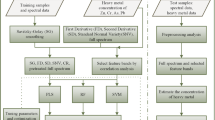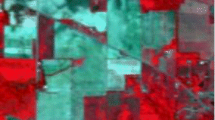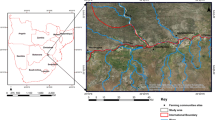Abstract
Visible and near-infrared (Vis–NIR) spectroscopy technology can better meet the needs of identification of mineral differences in iron ores by using a large amount of chemical bond vibration information contained in the spectra. In this paper, the original Vis–NIR spectra data of six kinds of iron ore are dimensionally reduced by the principal component analysis (PCA) algorithm, and the influence of sample noise and outliers is eliminated at the same time. After processing, the sum of the contribution rates of the first three principal components of the reflectance spectra reaches 99.27 pct, and the eigenvalue inclusion rate of the principal component analysis data is high, which has a good data processing effect. Then, based on the random forest (RF) algorithm, the spectra data after PCA are classified and predicted. After multiple authentications, the identification accuracy of the algorithm can reach more than 95 pct on average. Finally, the receiver operating characteristic (ROC) curve is used to characterize the prediction success rate of the recognition model and its accuracy for the recognition of single iron ore.










Similar content being viewed by others
Data availability
The datasets generated and/or analyzed during the current study are available from the corresponding author on reasonable request.
References
B.P. Yur’ev and V.A. Dudko: in Materials Science Forum, vol. 1052, Trans Tech Publications, 2022, pp. 262–66.
M. Iljana, T. Paananen, O. Mattila, M. Kondrakov, and T. Fabritius: Metals (Basel), 2022, vol. 12, p. 302.
Z. He, X. Hu, M. Lan, J. Liu, G. Cheng, X. Xue, and K. Chou: Minerals, 2021, vol. 11, p. 418.
M. Ostadrahimi, S. Farrokhpay, K. Gharibi, and A. Dehghani: Metall. Mater. Trans. B, 2020, vol. 51B, pp. 505–09.
Y. Cheng, Z. Shen, Y. Yang, Q. Liang, and H. Liu: Metall. Mater. Trans. B, 2022, vol. 53B, pp. 807–15.
K.M. Novack and M.M.C. Elias: ISIJ Int., 2013, vol. 53, pp. 1732–38.
M. Ostadrahimi, S. Farrokhpay, A. Farahani, K. Gharibi, and A. Dehghani: Metall. Mater. Trans. B, 2021, vol. 52B, pp. 3576–82.
T. Angelopoulou, A. Balafoutis, G. Zalidis, and D. Bochtis: Sustainability, 2020, vol. 12, p. 443.
P. Heidrich, E. Lambert, A. Kessler, M. Gerstenlauer, H. Heißler, T. Weber, J. Zipfel, M. Wüst, and R. Stamminger: J. Near Infrared Spectrosc., 2019, vol. 27, pp. 183–90.
Z. Yang, L. Cai, L. Han, X. Fan, and X. Liu: J. Near Infrared Spectrosc., 2021, vol. 29, pp. 313–20.
S. Xu, Y. Zhao, M. Wang, and X. Shi: Soil Sci. Soc. Am. J., 2018, vol. 82, pp. 1497–511.
D. Xiao, B.T. Le, and T.T.L. Ha: Spectrochim. Acta Part A, 2021, vol. 248, 119168.
M. Vitelli, H. Mehrtash, A. Assatory, S. Tabtabaei, R.L. Legge, and A.R. Rajabzadeh: Powder Technol., 2021, vol. 381, pp. 620–31.
L. Wang, Z. Huang, and R. Wang: Infrared Phys. Technol., 2021, vol. 115, 103731.
M. Lei, X. Yu, M. Li, and W. Zhu: Infrared Phys. Technol., 2018, vol. 92, pp. 177–82.
X. Zhang, L. Chen, Y. Sun, Y. Bai, B. Huang, and K. Chen: Spectrochim Acta Part A, 2018, vol. 193, pp. 133–40.
S. Wu, M. He, M. Yang, B. Zhang, F. Wang, and Q. Li: Crystals, 2021, vol. 11, p. 1130.
J.A. Coblinski, A.V. Inda, J.A.M. Dematte, A.C. Dotto, A. Gholizadeh, and E. Giasson: CATENA, 2021, vol. 203, 105334.
L.M. Kustov, V.Y. Borovkov, and V.B. Kazansky: J. Catal., 1981, vol. 72, pp. 149–59.
M. Fonteyne, J. Arruabarrena, J. de Beer, T. Hellings, M. Van Den Kerkhof, T. Burggraeve, A. Vervaet, C. Remon, and J.P. De Beer: J. Pharm. Biomed. Anal., 2014, vol. 100, pp. 21–27.
T. Shi, Y. Chen, Y. Liu, and G. Wu: J. Hazard. Mater., 2014, vol. 265, pp. 166–76.
J. Liu, J. Han, J. Xie, H. Wang, W. Tong, and Y. Ba: Spectrochim. Acta Part A, 2020, vol. 226, 117639.
R.S. Fard and H.R. Matinfar: J. Geosci., 2016, vol. 9, p. 745.
Acknowledgments
The authors gratefully acknowledge the financial support provided by the National Natural Science Foundation of China (52174291), the Central Universities Foundation of China (06500170), the Beijing New-star Plan of Science and Technology (Z211100002121115), the Guangdong Basic & Applied Basic Research Fund Joint Regional Funds-Youth Foundation Projects (2020A1515111008), and the China Postdoctoral Science Foundation (2021M690369).
Author information
Authors and Affiliations
Corresponding authors
Ethics declarations
Conflict of interest
On behalf of all authors, the corresponding author states that there is no conflict of interest.
Additional information
Publisher's Note
Springer Nature remains neutral with regard to jurisdictional claims in published maps and institutional affiliations.
Rights and permissions
Springer Nature or its licensor (e.g. a society or other partner) holds exclusive rights to this article under a publishing agreement with the author(s) or other rightsholder(s); author self-archiving of the accepted manuscript version of this article is solely governed by the terms of such publishing agreement and applicable law.
About this article
Cite this article
Liu, Z., Li, Z., Zhang, J. et al. Rapid, Non-destructive Identification of Iron Ores-Based Random Forest (RF) Using Visible and Near-Infrared Spectroscopy. Metall Mater Trans B (2024). https://doi.org/10.1007/s11663-024-03119-w
Received:
Accepted:
Published:
DOI: https://doi.org/10.1007/s11663-024-03119-w




